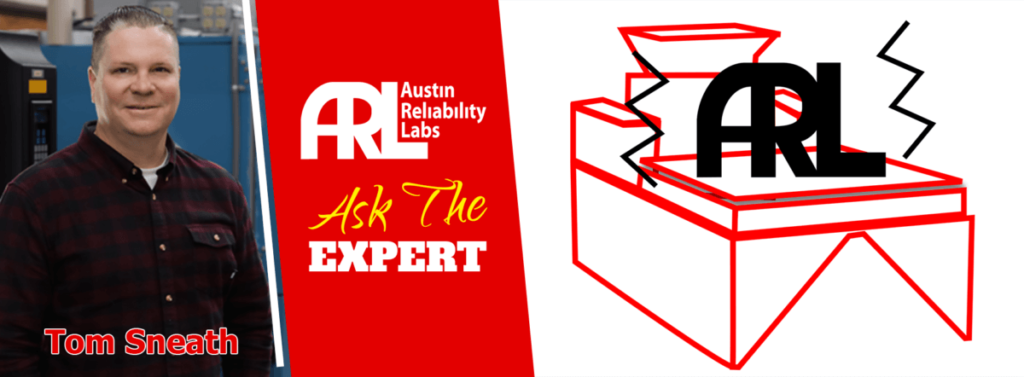
We recently spoke with our Reliability Lab Manager, Tom Sneath, who gave us an in depth look into shock and vibration testing: what it is, why use it, and when to use it.
What is Shock and Vibration Testing?
Vibration testing, like most reliability tests, recreates in a short amount of time a lifetime of stress that a product or assembly will experience. Stresses induced in vibration testing are the vibrations objects experience while in operation or in transport. These two types of use cases, operation and transport, often require different vibration frequencies that are achieved using either electrodynamic or hydraulic shaker tables. We’ve gone into detail about the differences between those tables in a previous article, but the essential summary is that hydraulic tables are more robust and provide a larger displacement (akin to a speed bump) while electrodynamic tables offer higher frequencies simulating environments such as the ring of a large church bell. Shock testing measures the impact of scenarios with sudden acceleration, such as drops, collisions, and explosions. Within certain parameters, a shaker table can be used for shock testing, but ARL’s dedicated shock towers provide a larger displacement. Shock and vibration testing are almost always prescribed in the same suite of tests, which is why they’re often mentioned together.
Who Benefits from Shock and Vibration Testing?
In many industries, there are already set standards for frequencies and durations to be used. Examples include aerospace, automotive, fluids, consumer and field-grade electronics, oil and gas, and packaging. ARL also uses its vibration tables in non-traditional ways, like in this case study where a vibration test was used to show how 3D printed automotive parts would degrade when exposed to wiper fluid. We’ve also used our shaker tables to find the resonant frequency of mechanisms so that they don’t experience a resonant disaster when subjected to the same frequency from an outside source. A classic example of this phenomenon is a wine glass shattering when subjected to a note that is the same as its resonant frequency. One industry that has seen steady growth in demand for these tests is food and beverage, due to the rise in popularity of proprietary packaging as well as increased transportation demands. In fact, increased transportation demands due to the continued rise of online ordering has caused an overall increase in demand for vibration testing. This increased demand also coincides with many products needing additional testing in response to increased warranty returns. Helping to remedy the impact of these types of situations – or preventing them altogether – is exactly what ARL is here for.
How Can ARL Help?
For the many industries that have set industrial standards, we can program and test to those standards and let product developers know if a product meets the standard and remains functional. If the test article doesn’t function after testing, ARL can provide a cause-of-failure analysis. ARL also provides reports and readouts of the wave patterns used.
For products without set standards, ARL works with customers to design a suite of tests directly tailored to a specific use case. When it comes to custom vibration testing, concern often centers around transportation, so we default to the MIL-STD-810 514.6 standard. Within this standard, there are different designations, like the US highway truck designation. We typically recommend drop testing to complement these tests, in which a package is dropped on each corner and edge from a prescribed height.
Beyond shock, vibration, and drop testing, ARL offers a whole host of other options. Environmental testing is commonly prescribed in conjunction with those mechanical tests, with some of the more common tests being ingress testing and temperature cycling. Beyond actual testing, ARL can also leverage its membership within the TyRex Technology Family to offer a wide range of consultation and design suggestions should your product produce less than satisfactory results during testing.
For more information or examples of how we can test your product, contact us here.

PEOPLE
Dedicated expertise working for you.
PARTNERSHIP
Successful business is a series of interlocking personal commitments.
PROCESS
Focused on innovation, entrepreneurship and community.
PURPOSE
Built to last, a proud member and resident of the community we serve.